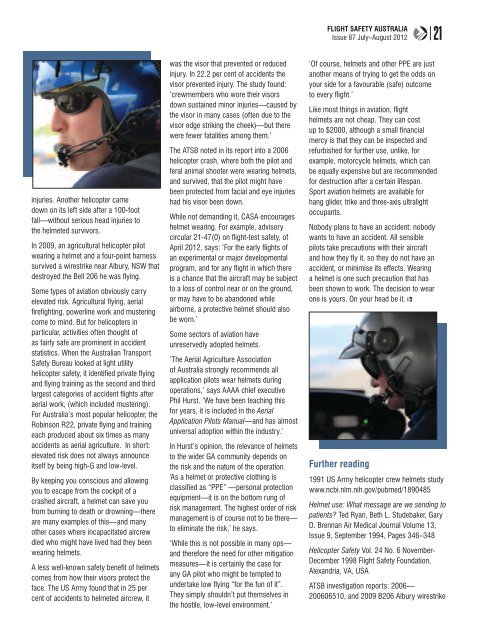jul-aug2012
Create successful ePaper yourself
Turn your PDF publications into a flip-book with our unique Google optimized e-Paper software.
Flight Safety Australia<br />
Issue 87 July–August 2012<br />
21<br />
injuries. Another helicopter came<br />
down on its left side after a 100-foot<br />
fall—without serious head injuries to<br />
the helmeted survivors.<br />
In 2009, an agricultural helicopter pilot<br />
wearing a helmet and a four-point harness<br />
survived a wirestrike near Albury, NSW that<br />
destroyed the Bell 206 he was flying.<br />
Some types of aviation obviously carry<br />
elevated risk. Agricultural flying, aerial<br />
firefighting, powerline work and mustering<br />
come to mind. But for helicopters in<br />
particular, activities often thought of<br />
as fairly safe are prominent in accident<br />
statistics. When the Australian Transport<br />
Safety Bureau looked at light utility<br />
helicopter safety, it identified private flying<br />
and flying training as the second and third<br />
largest categories of accident flights after<br />
aerial work, (which included mustering).<br />
For Australia’s most popular helicopter, the<br />
Robinson R22, private flying and training<br />
each produced about six times as many<br />
accidents as aerial agriculture. In short:<br />
elevated risk does not always announce<br />
itself by being high-G and low-level.<br />
By keeping you conscious and allowing<br />
you to escape from the cockpit of a<br />
crashed aircraft, a helmet can save you<br />
from burning to death or drowning—there<br />
are many examples of this—and many<br />
other cases where incapacitated aircrew<br />
died who might have lived had they been<br />
wearing helmets.<br />
A less well-known safety benefit of helmets<br />
comes from how their visors protect the<br />
face. The US Army found that in 25 per<br />
cent of accidents to helmeted aircrew, it<br />
was the visor that prevented or reduced<br />
injury. In 22.2 per cent of accidents the<br />
visor prevented injury. The study found:<br />
‘crewmembers who wore their visors<br />
down sustained minor injuries—caused by<br />
the visor in many cases (often due to the<br />
visor edge striking the cheek)—but there<br />
were fewer fatalities among them.’<br />
The ATSB noted in its report into a 2006<br />
helicopter crash, where both the pilot and<br />
feral animal shooter were wearing helmets,<br />
and survived, that the pilot might have<br />
been protected from facial and eye injuries<br />
had his visor been down.<br />
While not demanding it, CASA encourages<br />
helmet wearing. For example, advisory<br />
circular 21-47(0) on flight-test safety, of<br />
April 2012, says: ‘For the early flights of<br />
an experimental or major developmental<br />
program, and for any flight in which there<br />
is a chance that the aircraft may be subject<br />
to a loss of control near or on the ground,<br />
or may have to be abandoned while<br />
airborne, a protective helmet should also<br />
be worn.’<br />
Some sectors of aviation have<br />
unreservedly adopted helmets.<br />
‘The Aerial Agriculture Association<br />
of Australia strongly recommends all<br />
application pilots wear helmets during<br />
operations,’ says AAAA chief executive<br />
Phil Hurst. ‘We have been teaching this<br />
for years, it is included in the Aerial<br />
Application Pilots Manual—and has almost<br />
universal adoption within the industry.’<br />
In Hurst’s opinion, the relevance of helmets<br />
to the wider GA community depends on<br />
the risk and the nature of the operation.<br />
‘As a helmet or protective clothing is<br />
classified as “PPE” —personal protection<br />
equipment—it is on the bottom rung of<br />
risk management. The highest order of risk<br />
management is of course not to be there—<br />
to eliminate the risk,’ he says.<br />
‘While this is not possible in many ops—<br />
and therefore the need for other mitigation<br />
measures—it is certainly the case for<br />
any GA pilot who might be tempted to<br />
undertake low flying “for the fun of it”.<br />
They simply shouldn’t put themselves in<br />
the hostile, low-level environment.’<br />
‘Of course, helmets and other PPE are just<br />
another means of trying to get the odds on<br />
your side for a favourable (safe) outcome<br />
to every flight.’<br />
Like most things in aviation, flight<br />
helmets are not cheap. They can cost<br />
up to $2000, although a small financial<br />
mercy is that they can be inspected and<br />
refurbished for further use, unlike, for<br />
example, motorcycle helmets, which can<br />
be equally expensive but are recommended<br />
for destruction after a certain lifespan.<br />
Sport aviation helmets are available for<br />
hang glider, trike and three-axis ultralight<br />
occupants.<br />
Nobody plans to have an accident: nobody<br />
wants to have an accident. All sensible<br />
pilots take precautions with their aircraft<br />
and how they fly it, so they do not have an<br />
accident, or minimise its effects. Wearing<br />
a helmet is one such precaution that has<br />
been shown to work. The decision to wear<br />
one is yours. On your head be it.<br />
Further reading<br />
1991 US Army helicopter crew helmets study<br />
www.ncbi.nlm.nih.gov/pubmed/1890485<br />
Helmet use: What message are we sending to<br />
patients? Ted Ryan, Beth L. Studebaker, Gary<br />
D. Brennan Air Medical Journal Volume 13,<br />
Issue 9, September 1994, Pages 346–348<br />
Helicopter Safety Vol. 24 No. 6 November-<br />
December 1998 Flight Safety Foundation,<br />
Alexandria, VA, USA<br />
ATSB investigation reports: 2006—<br />
200606510, and 2009 B206 Albury wirestrike

















